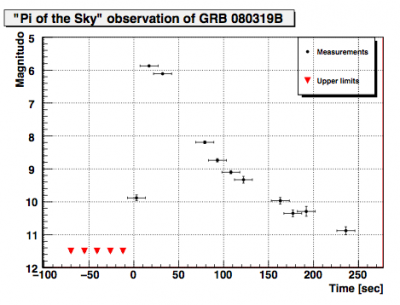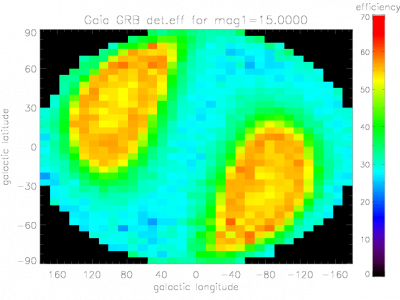Difference between revisions of "Triggers:GRBs"
Jure.Japelj (talk | contribs) |
Jure.Japelj (talk | contribs) |
||
| Line 3: | Line 3: | ||
Gamma-ray bursts (GRBs) are extremely energetic, brief and unpredictable explosions occuring on cosmological distances. They represent the most luminous events in the gamma-ray part of the electromagnetic spectrum known in the universe. Often, the prompt gamma-ray emission is followed by an afterglow emitted at longer wavelengths (from X-rays to radio), which can last for several days. Comprehensive review on GRBs and their physics can be found in [http://adsabs.harvard.edu/abs/2004RvMP...76.1143P Piran 2004] or [http://adsabs.harvard.edu/abs/2006RPPh...69.2259M Meszaros 2006]. | Gamma-ray bursts (GRBs) are extremely energetic, brief and unpredictable explosions occuring on cosmological distances. They represent the most luminous events in the gamma-ray part of the electromagnetic spectrum known in the universe. Often, the prompt gamma-ray emission is followed by an afterglow emitted at longer wavelengths (from X-rays to radio), which can last for several days. Comprehensive review on GRBs and their physics can be found in [http://adsabs.harvard.edu/abs/2004RvMP...76.1143P Piran 2004] or [http://adsabs.harvard.edu/abs/2006RPPh...69.2259M Meszaros 2006]. | ||
| − | GRB explosions are believed to be collimated, rather than spherical [http://adsabs.harvard.edu/abs/2007RMxAC..27..140G Granot 2007]. Thus the material, ejected by the explosion, is expanding in the form of a bimodal jet, characterized by an initial half-opening angle <math> | + | GRB explosions are believed to be collimated, rather than spherical [http://adsabs.harvard.edu/abs/2007RMxAC..27..140G Granot 2007]. Thus the material, ejected by the explosion, is expanding in the form of a bimodal jet, characterized by an initial half-opening angle <math>t_{j}</math>. The shape of the lightcurve depends on the relative position of the observer's line-of-sight and the axis of the jet cone. We can describe that with an angle $\theta_{\rm obs}$ between both directions. We talk about an on-axis GRB and a 'regular' optical afterglow when $\theta_{\rm obs} < \theta_{\rm j}$. In the case of $\theta_{\rm obs} > \theta_{\rm j}$, we can not observe the prompt gamma-ray emission. Due to the beaming effect, we could still observe the so called orphan afterglow (details in [http://adsabs.harvard.edu/abs/2007RMxAC..27..140G Granot 2007] or ). A schematic afterglow lightcurves for different jet half-opening angles and viewing angles are shown in Figure on the right. |
A large sample of observed optical lightcurves is shown in Figure 2. | A large sample of observed optical lightcurves is shown in Figure 2. | ||
Revision as of 15:09, 31 March 2011
Gamma-ray bursts (GRBs) are extremely energetic, brief and unpredictable explosions occuring on cosmological distances. They represent the most luminous events in the gamma-ray part of the electromagnetic spectrum known in the universe. Often, the prompt gamma-ray emission is followed by an afterglow emitted at longer wavelengths (from X-rays to radio), which can last for several days. Comprehensive review on GRBs and their physics can be found in Piran 2004 or Meszaros 2006.
GRB explosions are believed to be collimated, rather than spherical Granot 2007. Thus the material, ejected by the explosion, is expanding in the form of a bimodal jet, characterized by an initial half-opening angle <math>t_{j}</math>. The shape of the lightcurve depends on the relative position of the observer's line-of-sight and the axis of the jet cone. We can describe that with an angle $\theta_{\rm obs}$ between both directions. We talk about an on-axis GRB and a 'regular' optical afterglow when $\theta_{\rm obs} < \theta_{\rm j}$. In the case of $\theta_{\rm obs} > \theta_{\rm j}$, we can not observe the prompt gamma-ray emission. Due to the beaming effect, we could still observe the so called orphan afterglow (details in Granot 2007 or ). A schematic afterglow lightcurves for different jet half-opening angles and viewing angles are shown in Figure on the right.
A large sample of observed optical lightcurves is shown in Figure 2.
Observations made by the Swift satellite imply that there are approximately 300 on-axis GRBs per year for which we could observe an optical afterglow. Even though orphan afterglows have not been conclusively detected yet, they have been studied a great deal over the last 15 years and various estimations on their detectability have been made (Granot 2007 and references therein).
It has been observed, that the color indices $(R - I)$, $(V -R)$ and $(B - V)$ of a sample of observed afterglows are roughly constant in the first 10 days of observation, i.e. their time evolution is negligible. This property could serve as a mean to recognise an afterglow and to distinguish it from other possible sources Šimon et al. 2001 Šimon et al. 2004.
File:Kann afterglow.pdf from Wozniak et al. 2006
Detecting GRBs with Gaia
About 5% of GRBs is detectable by Gaia, with the highest efficiency close to the nodes. The main feature visible in the data is steady and rapid decline over AF CCDs. Time sampling at AF CCDs level is 4.4s per CCD. We also demand the transient to be visible in the second FOV (after 105 min).
 from Piran,2005
from Piran,2005
Color-color (B-V vs. V-R) diagram of optical afterglows of long GRBs. All the color indices were corrected for the Galactic reddening. Multiple indices of the same optical afterglow are connected by lines for convenience. Optical afterglows of the ensemble (Simon et al., 2001, 2004) are denoted by open red circles. The mean colors (centroid) of the whole ensemble, including the standard deviations, are marked by the large cross. The outlying optical afterglow of GRB 060218 (closed blue circles) is not included in the calculation of the centroid. The representative reddening paths for E(B-V) = 0.5 mag are shown; they show how much and where the observed data point would move without proper correction (even erroneous correction would thus shift the point only slightly and in predictable direction). Adapted from Simon et al., 2001, 2004, where a detailed information can be found.





